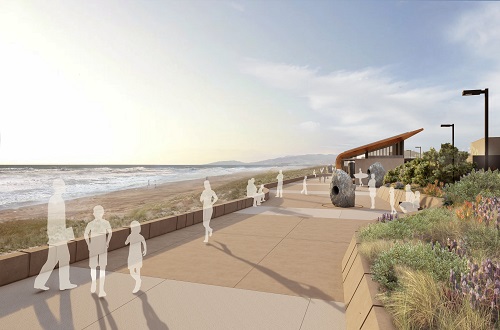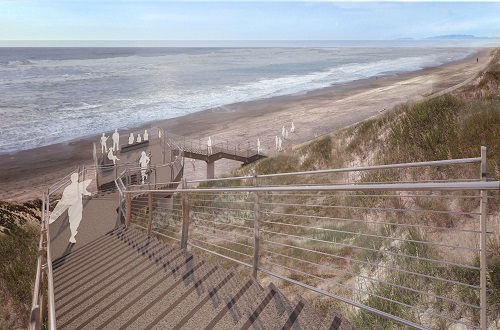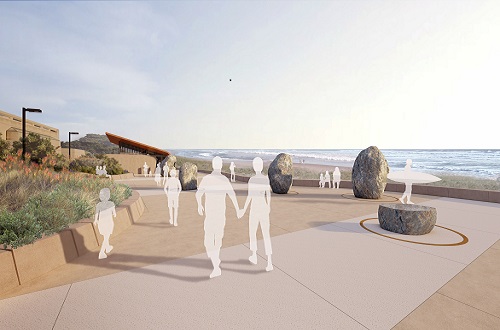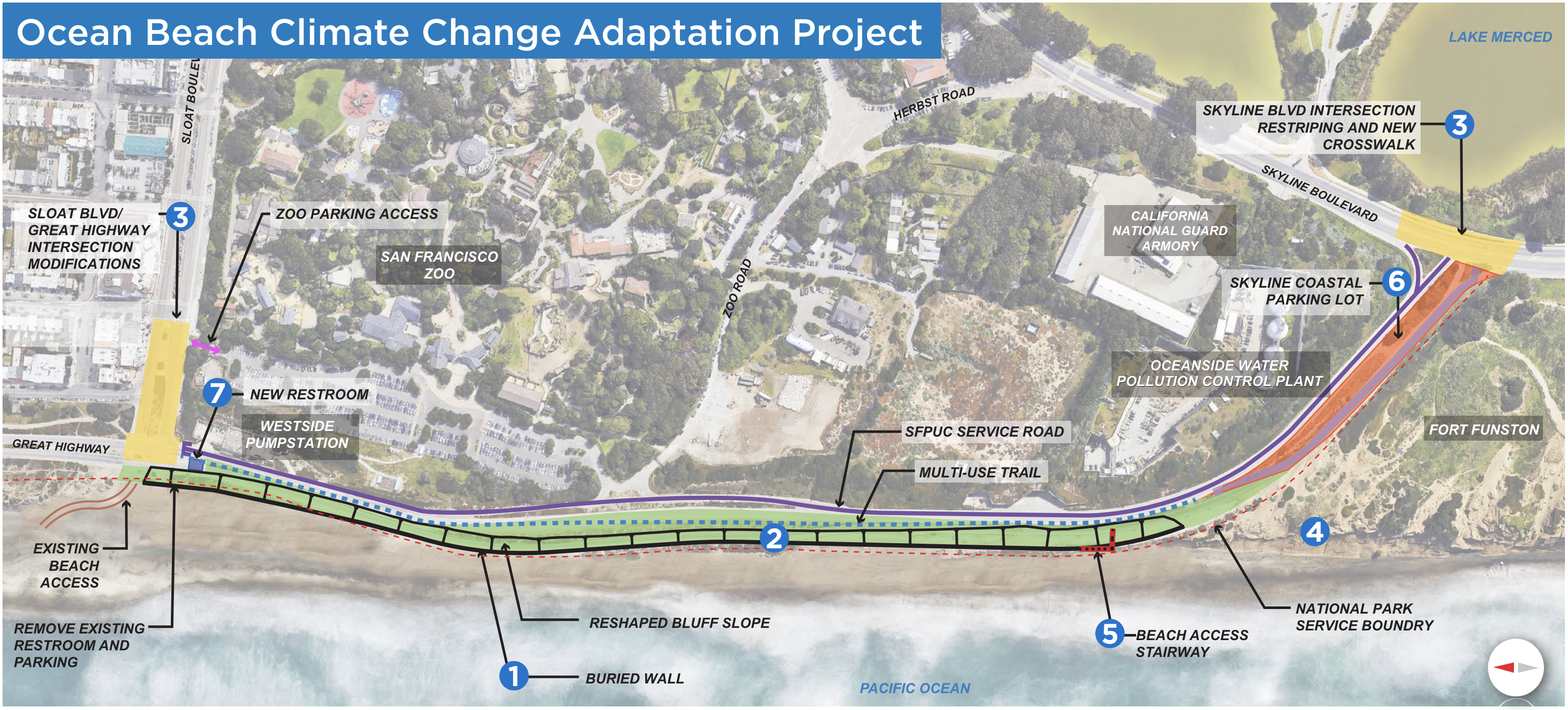Ocean Beach Climate Change Adaptation Project
- Contact: Elsa Eder, Public Information Officer
- phone(415) 554-3274
- mail_outline ssip@sfwater.org
Overview
The Ocean Beach Climate Change Adaptation Project will create new public open space, protect key public assets, and ensure coastal access in the face of climate change.
Project elements include constructing a buried seawall to protect a pump station, recycled water facility, wastewater treatment plant, and other key infrastructure. Other elements include rerouting Great Highway traffic between Sloat Blvd and Skyline Drive away from the narrowest part of the beach, building a multi-use public trail with sweeping Pacific Ocean views where the highway is now, and improving beach health through the replacement of sand.
- Construction Start: Late 2025
- Construction End: 4 years
- Project Phase: Planning
-
Project Background

Rendering of Sloat Plaza, featuring Listening Stones, a public art proposal by artist @mark_baugh_sasaki, commissioned by @sf_arts_commission in partnership with @mysfpuc. This project is the first major climate change adaptation project in San Francisco. It will create over a mile of new seaside trail; improve coastal access, recreation, and habitat at south Ocean Beach; and protect vital public wastewater and recycled water infrastructure. Climate change continues to threaten critical wastewater infrastructure and limit public shoreline access and recreational opportunities. Erosion from rising sea levels and intense storms will get worse, undermining and damaging parking lots, stormwater facilities, and the Great Highway.
Spring 2024 Updates
- In October 2023, the Planning Commission certified the Final EIR and the project was approved by the SFPUC and Recreation and Parks Commissions
- The Recreation and Parks Commission advanced closure of the Great Highway between Sloat and Skyline Boulevards to the Board of Supervisors.
- The current schedule estimates construction will begin in late 2025 and last for approximately four years.
- The project team is engaged with the California Coastal Commission on specific project details and conditions in the Coastal Development Permit. This process will likely result in project refinements and schedule delays. We will share updates as the process moves forward.
- You may have read in recent news coverage about the upcoming changes to the Great Highway south of Sloat Boulevard as part of this project. This spring, the Board of Supervisors approved the Great Highway road closure between Sloat and Skyline boulevards.
- Starting June 17, the San Francisco Public Works will begin the annual sand maintenance activities at Ocean Beach. City crews will redistribute approximately 30,000 cubic yards of sand over the next two weeks.
- People who walk and bike are encouraged to shift their activities to the northbound lanes while crews are on the job, Monday through Friday, from 7 a.m. to 4 p.m.

New coastal access stairs Objectives and Components
The Ocean Beach Project design is guided by shoreline management concepts recommended by The Ocean Beach Master Plan, a collaborative vision for San Francisco’s western coast, led by the San Francisco Bay Area Planning and Urban Research Association (SPUR), which brought together community members, city agencies, and the National Park Service.
The overarching purpose of the Ocean Beach Project is to implement a long-term coastal management strategy for South Ocean Beach that addresses shoreline erosion and climate-change-related sea level rise. Specific project objectives and components include:
- Protect Critical Infrastructure: Construct a buried wall to protect wastewater infrastructure and recycled water facilities from shoreline erosion.
- Preserve and Enhance Coastal Access, Recreation, and Habitat:
- Construct a multi-use trail, beach access stairway, restrooms, and complete Americans with Disabilities Act (ADA) access improvements along Ocean Beach north of Sloat Boulevard;
- Remove the shoreline protection structures and debris, reshape the bluff to increase accessible open space area, and plant native vegetation.
- Continue beach nourishment (sand replenishment) as needed.
- Implement Roadway, Safety & Parking Changes:
- Reroute Great Highway traffic away from the beach between Sloat and Skyline boulevards
- Improve Adjacent Intersections: Improve the intersections at Great Highway and Sloat and Skyline boulevards to facilitate the changes in travel patterns resulting from closing this section of the Great Highway. The SFMTA is planning additional intersection improvements at the Sloat and Skyline intersection and along Sloat Boulevard.
- Parking: Construct a new parking lot with approximately 60 parking spaces near the southern end of the project’s multi-use trail (near Skyline Boulevard/Great Highway intersection). The 35-space parking lot at Great Highway and Sloat Boulevard will be removed.
- Additional: Reroute Muni 23 Monterey bus layover and turn-around, reconfigure San Francisco Zoo parking entrance to ensure smooth access, and maintain a service road to SFPUC facilities.
_500x330.jpg)
Multi-use trail and new restrooms Project Status
The project has been approved by the SFPUC and RPD Commissions and is ready to move forward. Last up will be approval of the Great Highway road closure between Sloat and Skyline boulevards by the Board of Supervisors and approval by the California Coastal Commission. Construction anticipated to begin in late 2025 and last 4 years.
-
2012 Ocean Beach Master Plan
In 2012, the Ocean Beach Master Plan, an inter-agency effort led by SPUR, recommended a sustainable long-term vision for all of Ocean Beach. The Master Plan presents six key moves that are organized by geographical reaches and designed to be implemented incrementally over a period of decades. The Ocean Beach Climate Change Adaptation Project focuses on south Ocean Beach and includes two of the six key moves.
- Removal of the Great Highway between Sloat and Skyline Boulevard.
- The introduction of a multipurpose coastal protection/restoration/access system.

Multi-use trail - looking south from Sloat Plaza The Project is being implemented in three sequential sub-phases: 1) Short-term Improvements, 2) Army Corps of Engineers Beach Nourishment, and 3) Long-term Improvements. The Long-term Improvements phase will require on-going, beach nourishment via sand placement.
Short-Term Improvements Phase (underway)
The Short-Term Improvements Phase has been underway for several years and provides interim protection and improved beach access while the Long-term Improvements Phase is under development. The Short-term activities include beach nourishment activities and installation of sandbags along the southern portion of Ocean Beach fronting the Great Highway. This work is a critical environmentally friendly approach to protect public infrastructure and improve beach access until the Long-term Improvements Phase is ready for implementation. Potential annual sand replenishment activities in this phase are informed by annual monitoring efforts required by the City’s Coastal Development Permit.
United States Army Corps of Engineers Beach Nourishment Phase (Completed, with ongoing coordination)
This work beneficially used the dredged sand to minimize storm damage and protect the beach, infrastructure, habitat, and recreational access to the beach. Construction was completed in summer 2021.
Long-Term Improvements Phase
This phase of work would improve access, recreation, and habitat at South Ocean Beach and protect vital public wastewater and recycled water infrastructure. The Long-term Improvements Phase is currently in the design and environmental review phase (the Notice of Preparation can be viewed here). The Draft Environmental Impact Report was released on December 8, 2021. The Final EIR is in development and is expected to be published in early 2023. Construction is expected to begin in late 2024 and last for approximately four years.
Beach Access During Construction:
During construction, portions of South Ocean Beach would be closed to public access. Beach closure would likely be required for approximately six months per year, for each of the four years of construction. Walking along the beach from the water would be allowed during construction; however, access would be restricted to the nearshore area outside of construction zones. More information will be available ahead of and during construction, expected to start in mid-2024.
-
Project Materials


